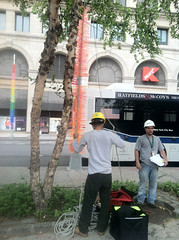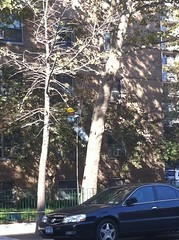 Stephen Rex Brown The arborists prepare to climb trees at Astor Place.
Stephen Rex Brown The arborists prepare to climb trees at Astor Place.Tree-climbers are searching for the dreaded Asian longhorned beetle at Astor Place today. An arborist at the scene said that no beetles had recently been spotted, but that the area was contaminated about four years ago, so investigators are being “extra careful.”
The climbers typically look for circular, pencil-diameter holes in the trees, the signature of the Chinese beetle that first appeared in the city — and in the U.S. — in 1996. When a beetle is found, it spells the destruction of the infested tree and usually many of the other trees nearby in an attempt to quarantine the insect.
The tree-climbers are a fairly common sight in the neighborhood. Late last year they were spotted on Avenue A.
 Suzanne Rozdeba Inspectors look for signs of the longhorned beetle.
Suzanne Rozdeba Inspectors look for signs of the longhorned beetle.Climbers from the federal Department of Agriculture were spotted today inspecting trees on Avenue A for signs of the dreaded Asian longhorned beetle, an invasive species that virtually guarantees the death of any tree it infests.
The Parks Department confirmed that the climbers were between Fourth and Fifth Streets at around 11:30 a.m. inspecting the trees for the circular, pencil-diameter holes that indicate the presence of the Chinese beetle that first appeared in the city — and in the U.S. — in 1996.
Since then, the beetle has been spotted in Central Park, Staten Island, parts of Brooklyn, and even as far away as Chicago. Typically, when a tree is found to be infested it is cut down, chopped up and burned. Trees in its immediate vicinity may also be felled in an attempt to quarantine the pest. Trees within a wider radius may be treated with an insecticide, as well. Read more…





